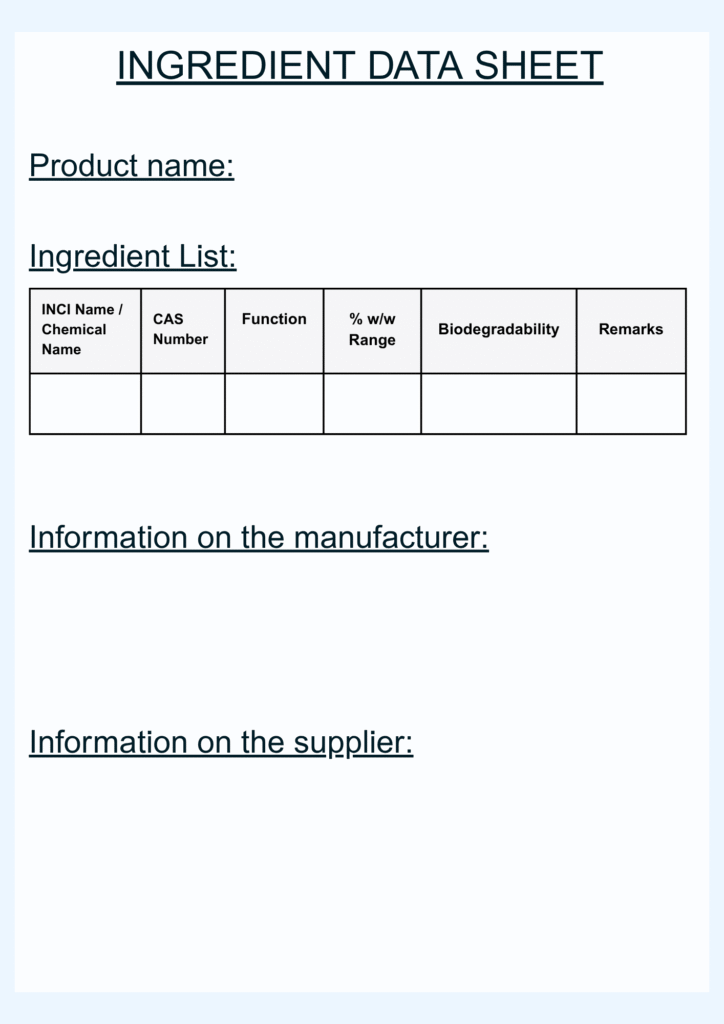What is an Ingredient Data Sheet?
An Ingredient Data Sheet (IDS) is a document specifically used for certain product categories, such as detergents, that provides detailed information about the substances contained in the product. The IDS is intended to inform medical personnel or competent authorities about the product’s composition, particularly in cases of accidental exposure or medical emergencies.
Ensure compliance with EU regulatory requirements for your detergent products through our Ingredient Data Sheet (IDS) preparation service. Chemleg supports manufacturers, importers, and private label brands in complying with the Detergent Regulation. We help ensure transparent and accurate product information is available to authorities, retailers, and consumers.
What Does the Ingredient Data Sheet Contain?
The EU Detergents Regulation includes the following provision regarding the content of the Ingredient Data Sheet:
“The following provisions shall apply to the listing of ingredients on the datasheet referred to in Article 9(3).
The datasheet shall list the name of the detergent and of the manufacturer.
All ingredients shall be listed in order of decreasing abundance by weight and subdivided into the following weight percentage ranges:
– 10 % or more,
– 1 % or over, but less than 10 %,
– 0.1 % or over, but less than 1 %,
– less than 0.1 %.
Impurities shall not be considered to be ingredients.
The common chemical name or IUPAC name, the CAS number, and, where available, the INCI name and the European Pharmacopoeia name, shall be given for each ingredient.”
An addition to the Detergents Regulation by Regulation (EC) No. 907/2006 includes the following statement:
“Perfumes, essential oils, and colorants are considered single ingredients. However, allergenic substances listed in Annex III, Part 1 of Directive 76/768/EEC must be declared if their concentration exceeds 0.01% by weight, as set out in Section A of Annex VII of the Detergents Regulation.”
How Is an Ingredient Data Sheet Different from an SDS or TDS?
The Ingredient Data Sheet (IDS) outlines all components of a product, particularly for emergency medical use. In contrast:
- The Safety Data Sheet (SDS) provides detailed information on the safe handling, storage, and disposal of hazardous substances, focusing on workplace safety.
- The Technical Data Sheet (TDS) highlights the physical, chemical, and performance characteristics of the product, serving technical users such as engineers and applicators.
The differences are summarized in the table below:
Feature | Ingredient Data Sheet (IDS) | Safety Data Sheet (SDS) | Technical Data Sheet (TDS) |
Primary Focus | Detailed breakdown and concentration ranges of all product components. | Comprehensive safety information on hazards, handling and storage. | Technical specifications, performance data, and application guidelines. |
Main Purpose | To provide immediate compositional data to medical professionals in emergencies. | To ensure workplace safety and manage risks associated with hazardous chemicals. | To explain product use, functions, and technical capabilities. |
Target Audience | Medical personnel (e.g., poison centres), regulatory authorities. | Professional users, employers, safety officers, emergency responders. | Engineers, technicians, designers, procurement staff, and end-users in technical contexts. |
Legal Status | Required under the EU Detergents Regulation (EC) No 648/2004. | Mandatory under REACH (EC) No 1907/2006 and CLP (EC) No 1272/2008. | Not legally required, but often expected under industry standards or contracts. |
Content Coverage | Product name and manufacturer, full list of ingredients with concentration ranges. | 16-section format covering hazards, first aid, fire response, disposal and more. | Physical/chemical data (e.g., density, pH, viscosity), performance metrics, storage guidelines. |
Standardization | Guided by general rules in the Detergents Regulation; less standardized than the SDS. | Globally harmonized 16-section format under GHS. | No universal format; varies by product and manufacturer. |
Key Considerations When Preparing an Ingredient Data Sheet for Detergents
The foundational regulation governing IDS preparation in the EU is the Detergents Regulation (EC) No 648/2004. An IDS must be fully compliant with this regulation, containing complete, accurate, and up-to-date information that is readily accessible to medical personnel upon request. It should always be presented in a clear, legible, and professional format.
Given the complexity of ensuring full compliance, it is advisable to seek support from specialized consultancy firms, such as Chemleg, with expertise in regulatory documentation.
An example of an IDS prepared in accordance with the Regulation is provided below.

The Chemleg Advantage in Ingredient Data Sheet Services
An improperly prepared IDS can lead to regulatory non-compliance and legal consequences. Chemleg’s team of experts in detergent and chemical compliance offers tailored solutions for detergent formulations, ensuring that your IDS is prepared and maintained accurately and on time. From initial formulation review to final document validation, Chemleg provides full support throughout the process.
EU Ingredient Data Sheet Service Includes:
- Regulatory Compliance & Data Verification
- Preparation of the Ingredient Data Sheet
- Labelling & Website Disclosure Compliance
- Submission to Authorities & Poison Centers
- Periodic Updates & Compliance Review
Fill out the form now and let’s begin your IDS preparation process.
Frequently Asked Questions
Is it mandatory to prepare an Ingredient Data Sheet for detergents?
Yes. Under the EU Detergents Regulation, an Ingredient Data Sheet must be prepared for detergent products and made accessible upon request.
Is an Ingredient Data Sheet the same as a Product Data Sheet?
No. The IDS legally required document that provides a full breakdown of all ingredients, while the Product Data Sheet includes general product information such as usage instructions and performance data, and is not typically mandatory.
Where should the Ingredient Data Sheet be published?
The IDS must be published on a publicly accessible website by the manufacturer and provided without delay to medical personnel upon request. The website address should be indicated on the product packaging or in the SDS.
How often should the IDS be updated?
The IDS must be updated whenever there is a change in the product formulation that affects ingredient composition or concentration.









